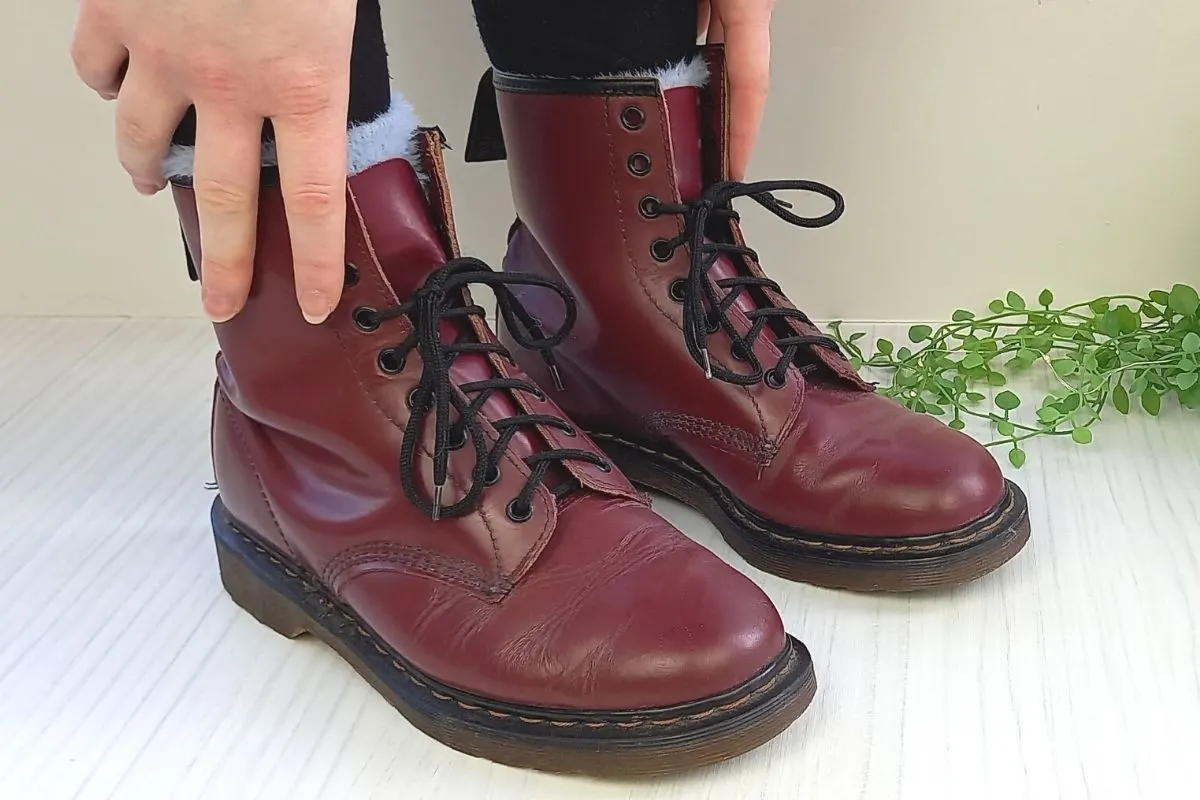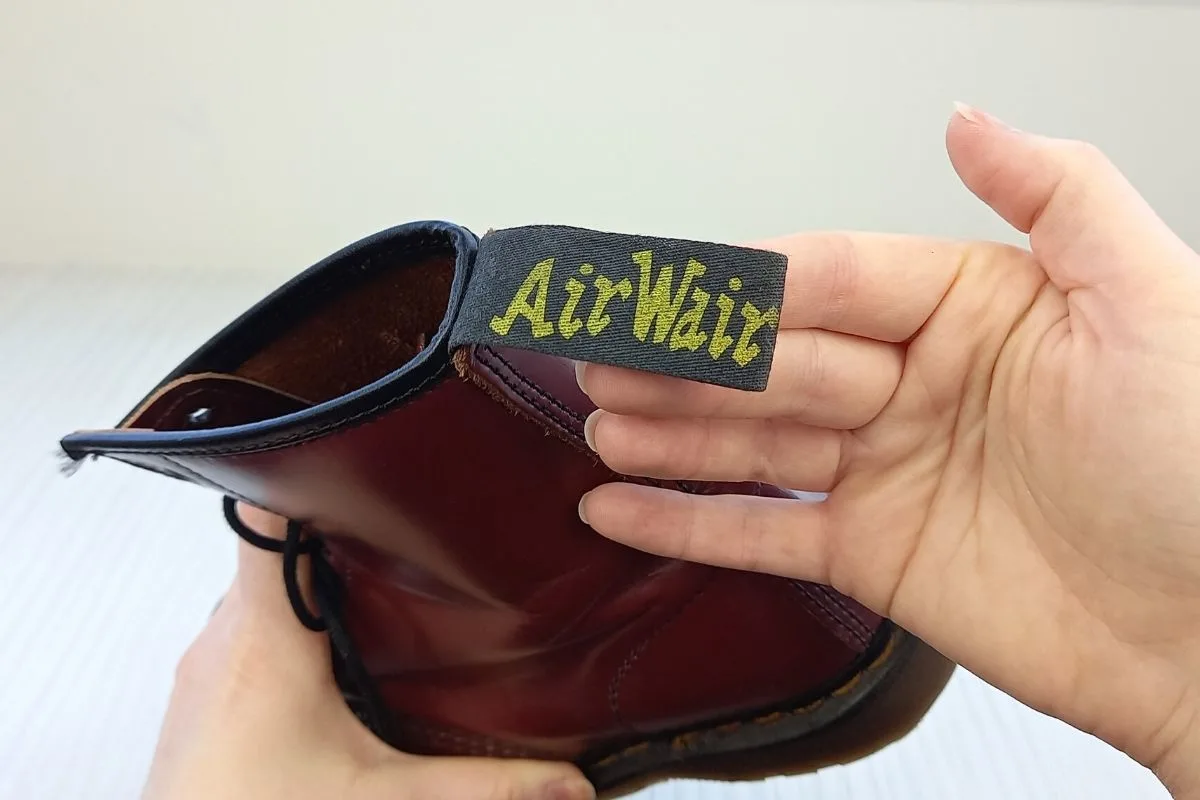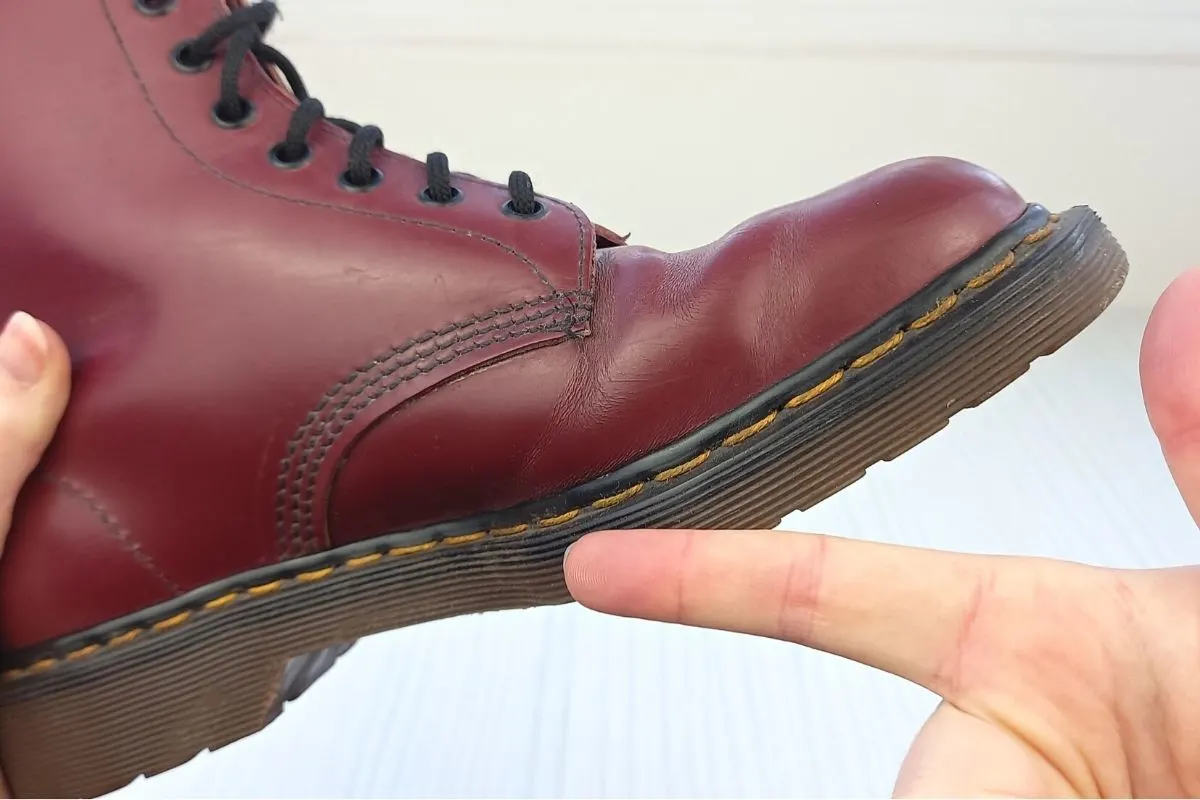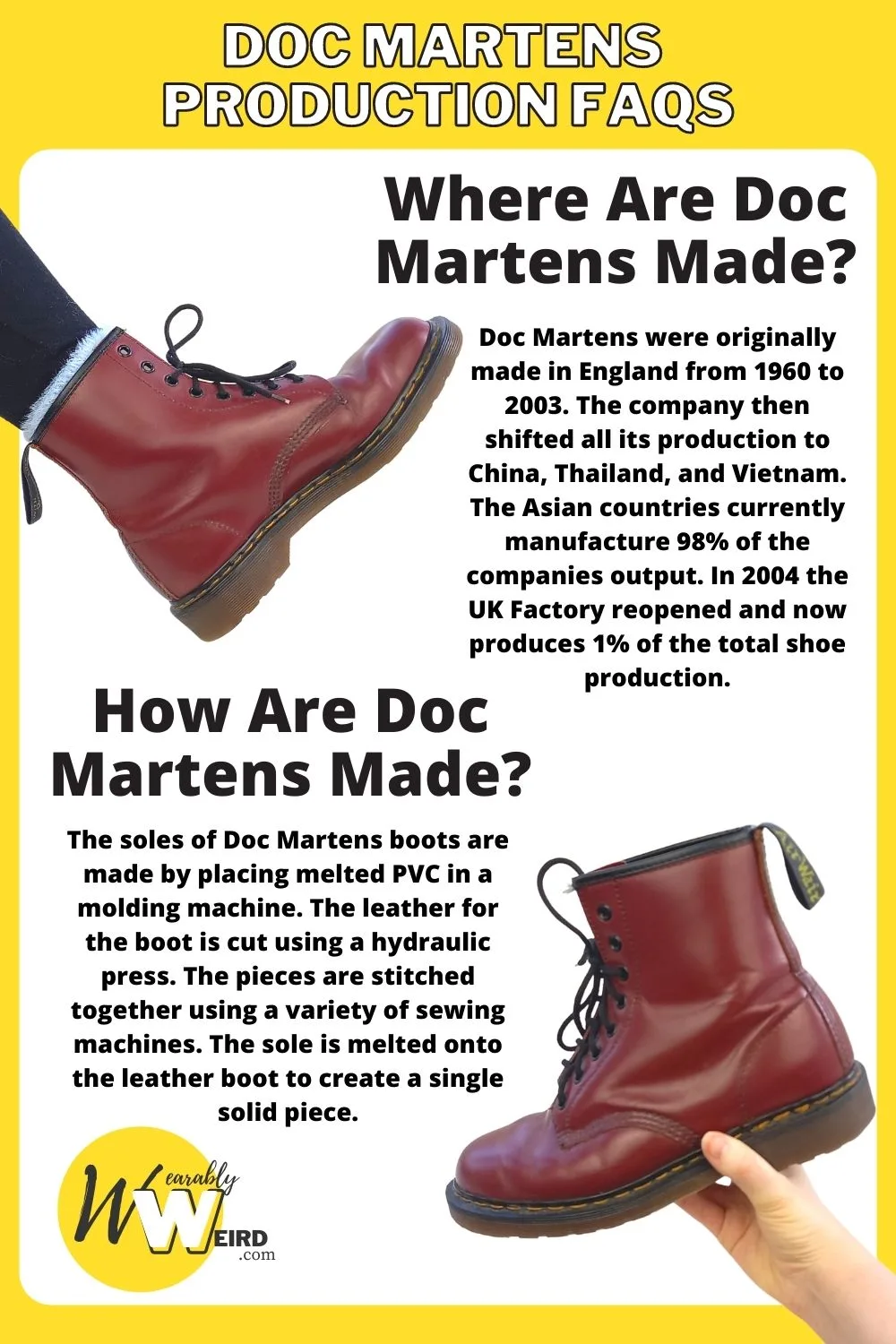The Doc Martens brand is synonymous with many subcultures and has become an iconic brand in the world today. The famous ‘1460’ style boot is loved and worn by many, but where are Doc Martens made currently?
As a long term fan and customer of the Doc Martens brand I have written this FAQ guide covering where and how Doc Martens are made, along with a cool history timeline and some fun facts (plus pictures of my own pair of vintage Docs)!
*This page may contain affiliate links. As an Amazon Associate I earn from qualifying purchases at no additional cost to you. Learn More.
Where Are Doc Martens Made?

Doc Martens were originally made in England from 1960 to 2003. The company then shifted all its production to China, Thailand, and Vietnam. The Asian countries currently manufacture 98% of the companies output. In 2004 the UK Factory reopened and now produces 1% of the total shoe production.
Visit the official Doc Martens website drmartens.com to see the quality of the boots and read their quality guarantees. Or if you like, check out my personal review guide on the quality of Doc Martens – Are Doc Martens Worth It? A 10 Year Doc Martens Review.
A History of Doc Martens Production
A doctor in the German Military in World War 2, named Klaus Märtens, had injured his ankle and found that the army-issued boots would not suffice. He then designed an improved pair of boots while recovering from an ankle injury; he incorporated soft leather and air-padded soles into the design of his boots. After the war, Klaus Märtens gathered the correct materials and made himself a pair of boots.
1947 –
Klaus Märtens did not have any success marketing his new boot design, but in 1947 he met up with an old friend, Herbert Funck, in Munich, Germany. The two friends added new rubber molded soles to the boot’s design. The new boots were extremely comfortable and sought after by working women, with 80% of the clientele being women over forty.
1959 –
In 1959, Märtens and Funck took their company international, and British shoemaker R. Griggs purchased the patent rights to make the boots in the United Kingdom. R. Griggs rebranded the boots as “Dr. Martens,” added the yellow stitching, and trademarked the soles as ‘AirWair’, turning the boots into the iconic brand we know today.
1960s –
In 1960, the 1460 (1/4/1960) style cherry-red color, smooth-leather boot was the inaugural boot style made by Doc Martens in the UK. The following year they launched a shoe with the same coloring, the 1461 (1/4/1961) style. The shoes were manufactured in a factory in Cobbs Lane, Wollaston Northamptonshire.
Here is a photo of my vintage pair of cherry red smooth leather Doc Martens:

As you can see they feature the ‘Airwair’ tag:

They also feature yellow stitching:

With the high demand for the boots, R. Griggs allowed other shoe manufacturers to produce the Doc Martens shoes under license, with very strict quality standards.
1970s to 1990s –
In the 1970s, the Doc Martens brand became synonymous with the many subcultures of the time, such as punks, musicians, and bike riders.
The Accent Group became the first company to manufacture Doc Martens outside of the UK and opened a factory in Dunedin, New Zealand, in 1989.
2000s to today –
In the early 2000s, the Doc Martens shoes were sold under the AirWair name and offered a large variety of styles and colors. Still, the sales plummeted, and the company faced bankruptcy in 2003. Doc Martens stopped manufacturing shoes in the UK and outsourced all shoe production to China and Thailand.
Doc Martens launched the “Vintage” line in 2004 and again started making shoes in the Cobbs Lane factory in the UK. The “Vintage” line would manufacture the shoes to the original specification of the 1460 and 1461. The Cobbs Lane factory can make 50 pairs of shoes per day with the “old school” methods and currently produce 1% of the company’s total yearly production.
The Doc Martens quality is still the major contributor to the sales of these iconic shoes. With 98% of the production coming from Asia, the quality control is of the highest standards and best quality materials.
You may also like: Do Doc Martens Run Big? – A Sizing Review With Photos
How Are Doc Martens Made?
The soles of Doc Martens boots are made by placing melted PVC in a molding machine. The leather for the boot is cut using a hydraulic press. The pieces are stitched together using a variety of sewing machines. The sole is melted onto the leather boot to create a single solid piece.
Here is a great YouTube video showing the production process:
1. Making the PVC Sole
The first step is to cast the PVC sole; this is done by injecting liquid PVC into a mold and clamping it down to cure. The PVC sole is acid, oil, and alkali resistant, and it softens with use, reducing cracking and splitting.
2. Making and stitching the Leather Shapes
In the Clicking room, all the leather shapes are cut with a hydraulic press to ensure minimal waste. Each shoe size has a standard mold used for correct sizing, and all the leather shapes are checked for quality and thickness.
The leather shapes are passed on to the Closing room, where all the pieces are sewn together. Each machine in the Closing room serves a unique function in the closing process, but the most iconic machine is the “Puritan” Stitching machine. The Puritan stitch is the unique 3-row stitch found on the cheek of the boots, making it more robust and flexible.
Before the boot leaves the Closing room, the eyelets are stamped in, the front of the boot is shaped, and a toe protector is added.
3. Yellow Stitching and Sealing the Soles
The leather upper of the boot is molded to a foot shape, and the excess leather is trimmed away. The yellow thread is sewn on with a PVC rim, and the sole is added to the boots so that the rim and sole touch. The rim and the sole are then melted on by using high heat. The heat causes the two PVC parts to become one solid piece and melt onto the boot, which seals the soles.
The final stage is the Shoe room when the boot receives a polish and is quality checked. The laces and the sock protectors are added, and the Doc Marten boot is packaged and ready for the customer.
Here is a handy info graphic summarising the above information:

Are Doc Martens Stitched Or Glued?
The leather pieces of a Doc Marten shoe are stitched together using an array of different stitches. The most iconic stitch is the 3-row stitch pattern that runs on the cheek of the shoe. The stitch pattern can only be performed by a Puritan stitching machine.
The yellow stitching found on the upper sole is stitched to form a rim for the sole to be attached to. The shoe’s sole is not glued but melted onto the shoe to form a single solid PVC sole.
Doc Martens FAQs
Below are a few FAQs about Doc Martens.
Are Doc Martens Made In China?
Doc Martens have been manufactured in Asia since 2003, with factories being set up in China, Thailand, and Vietnam. Doc Martens has set forth very stringent quality controls to ensure all shoes that leave these factories are of the highest quality.
The demand for Doc Marten shoes has been increasing steadily, and to meet the demand, other alternate factories were opened. The most inexpensive area to achieve this was Asia. The region is now producing 98% of all the shoes in the market today.
Are Doc Martens Made In England?
Doc Martens are still being manufactured in England, but of all the shoes produced, it only counts for 1% of the yearly production. The Doc Martens UK factory is situated in Cobbs Lane, Wollaston, Northamptonshire, and are the sole manufactures of the “Vintage” line. This line is made with the original specification shoes from 1960.
Doc Martens Made In England vs. China (What Are The Differences?)
- The “Made in England” Doc Martens have slightly thicker gauge leather than China or Asian makes. The leather will also need a short break-in period to soften and mold to your foot.
- The Doc Martens manufactured in China or Asia are branded “For Life” instead of “Made In England.” The leather is a thinner gauge, and the boot does not need a break-in period as the leather is softer. The soles of the “For Life” Doc Martens are not as durable as the original and can wear out quicker.
- The “Made in England” and the “For Life” boots are very well made and have passed the stringent quality control checks as set up by Doc Martens.
Related Articles
Thank you for reading this guide on the manufacturing of Doc Martens! I hope you now have plenty of new facts about the brand to inform your future purchases.
For more Doc Martens content, check out:
BEST Socks To Wear With Doc Martens – Comfort & Style Review
Are Doc Martens Comfortable? A Review With Photos
Are Doc Martens Waterproof? – A Review With Photos
How to Break in Doc Martens Fast – ULTIMATE Guide
21 Best Doc Martens Alternatives (Affordable Picks)

Lorna is a footwear geek and the founder of Wearably Weird. She created a YouTube channel in 2021 for fellow footwear fanatics, dedicated to detail-rich footwear reviews and info. She has a fashion media qualification (awarded in 2011).
